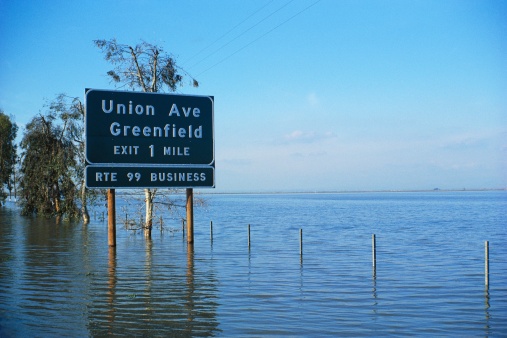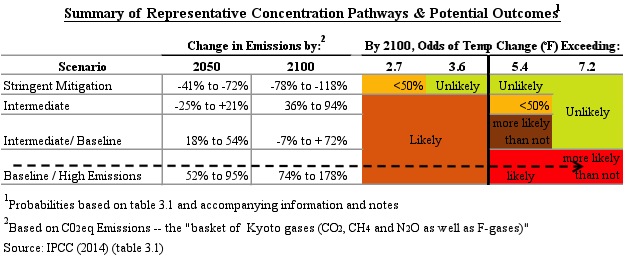
U.N. Panel’s final report comes at a delicate inflection point for policy makers.
Evidence of global warming is “unequivocal,” according to a recently released report by the Intergovernmental Panel on Climate Change (IPCC). The IPCC also expressed “high confidence” that the current emissions trajectory will lead to “severe, pervasive and irreversible impacts for people and ecosystems” by 2100.
“Time is not on our side,” lamented United Nations (UN) Secretary General Ban Ki-moon upon the release of the IPCC report.
The report comes at what may prove to be a pivotal time for international negotiations over climate change. The U.S. and China recently signed a historic accord, yet some in Congress remain opposed to regulatory action to reduce carbon emissions and have threatened to resist it. Low energy prices are further reducing the incentives for policy action in the United States.
Against the backdrop of these recent developments, the IPCC’s Fifth Assessment Synthesis Report provides a foundation for a potential international agreement on binding emissions reduction at the UN’s Paris Summit in late 2015. To prepare for the Summit, the IPCC completed the Herculean task of incorporating much of the existing academic literature into what is widely considered the most authoritative statement of what is known about climate change.
The IPCC’s report begins by framing climate change in terms of risk – the chance of “hazardous events” occurring multiplied by “the magnitude of the consequences.” In this context, a low-probability, but high-magnitude event – like catastrophic flooding – can be just as a bad as one that is much more likely but less devastating. In other words, the consequences of climate change array along a continuum of possibilities, each rather literally representing a different state of the world.
The report is divided into four parts: (i) observed changes; (ii) expected future impacts; (iii) mitigation and adaptation strategies; and (iv) policy implications.
The first part of the report details what are largely factual findings with respect to climate change and the causal mechanisms underlying it. The report states that “human influence on the climate system is clear.” Between 1970 and 2010, 78% of the increase in emissions came from fossil fuel combustion, overwhelming the climate system’s natural carbon removal mechanisms. As a result, greenhouse gas concentrations have reached a level the IPCC says is “unprecedented in at least the last 800,000 years.”
Climate change and its second-order effects have already devastated some natural systems, according to the IPCC. While the impact has been less pronounced for humans thus far, the report documents “global scale changes in the frequency and intensity of daily temperature extremes,” including a doubling of the propensity for heat waves in some areas.
The second part of the IPCC’s report warns that, if unabated, climate change will “amplify existing risks and create new ones.” The report presents a range of potential scenarios, focusing on what it calls the four Representative Concentration Pathways (RCPs). These RCPs – or projections for future growth in greenhouse gas emissions – range from taking no action to significant reductions in greenhouse gases.
Notably, under all four RCPs – even the one with the most significant reductions – there remains at least a nontrivial chance of global warming exceeding the critical 3.6° F threshold by 2100. The 3.6° F threshold is a level the IPCC found to be the maximum temperature accretion that can occur without unacceptable risks of “irreversible” damage.
The table below, a simplified summary of Table 3.1 from the IPCC’s report, illustrates the four RCPs. The dotted arrow shows the current trajectory of global warming, which, according to the IPCC, is “more likely than not” to exceed 7.2°F by 2100. The report states with “high confidence” that this trajectory presents major risks of “substantial species extinction, global and regional food insecurity, [and] consequential constraints on common human activities.”

This summary of the IPCC’s analysis helps illustrate a crucial point: there appears to be no state of the world in which human intervention improves the environment. As a consequence, climate change innately decreases our expected value: in finance terms, the potential return – in this case always negative – multiplied by its probability. Through the lens of risk, climate change creates a potential harm of uncertain magnitude (albeit, for the time being, one largely confined to statistical models rather than experienced reality).
The abstract nature of the harms from climate change, combined with loss aversion – or the psychological phenomenon of feeling the pain of losses more than the pleasure of comparable gains – make it exceedingly difficult for nations to reach a global agreement. The recent U.S. – China accord demonstrates the potential for viable international cooperation, but thus far has been the exception rather than the norm.
In its third part, the IPCC’s report focuses on strategies for mitigating climate change while also adapting to its effects and maintaining economic development. Although adaptation can “reduce the risks of climate change impacts,” the report emphasizes the paramount importance of reducing emissions. Based on scenarios that begin reductions immediately and set a “single global carbon price,” the IPCC estimates mitigation will reduce the annual growth rate of consumption – essentially, the additional amount consumers can spend each year – by a median of .06%, to between 1.54% and 2.94%.
Although carbon pricing remains controversial in the U.S., the nonprofit Carbon Disclosure Project has found what it purports to be “a global corporate consensus” on putting a price on carbon emissions. Even major corporations are managing their own operations with the expectation that carbon emissions will be priced. For example, ExxonMobil incorporates “shadow prices” for carbon into its long-term project planning, setting a rate of $60 a ton by 2030 and $80 a ton by 2040.
Exxon’s internal carbon pricing is notably similar to the International Monetary Fund’s (IMF) current $57 per ton estimate of the social costs of carbon and materially higher than the U.S. administration’s estimate of $35 per ton. Based on the IMF’s $57 per ton price and the midpoint of the IPCC’s emissions estimates, the current annual global cost of carbon emissions adds up to about $2.8 trillion. Importantly, this represents the externality generated by carbon emissions – not the cost of mitigating climate change. The impact on the economy can be significantly reduced by shifting energy production towards alternatives, which have rapidly decreased in cost, approaching parity with fossil fuels.
The final part of the IPCC’s report stresses that a comprehensive climate change policy necessitates robust international, regional, and national collaboration that is integrated with “societal objectives” like sustainable development.
The report also highlights an important challenge to securing international agreement. Although the effects of climate change are felt around the world, not all nations are equally affected, equally responsible, nor equally equipped to reduce the risks. Fossil fuel production also remains a backbone of many nations’ economies, including those of Russia, Nigeria, Canada, and Australia.
To help poorer countries adapt to the adverse effects of climate change, the U.S. recently committed to underwriting $100 billion annually by 2020, “as long as America’s demands for a global warming pledge are met.” In an effort to fulfill that promise, President Obama pledged $3 billion to a UN-backed fund at the G20 summit in Brisbane, while at the same time prodding the host country to “step up.”
The IPCC – which shared the 2007 Nobel Peace Prize with Al Gore – is a multinational research body supporting the United Nations Framework Convention on Climate Change (UNFCCC). The UNFCCC was ratified by 196 nations with the goal of limiting temperature increases relative to the pre-industrial period to 2° Celsius (3.6° F) by 2100.



